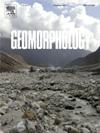利用无人机摄影测量评估泥石流沿岸巨石的时空分布情况
IF 3.1
2区 地球科学
Q2 GEOGRAPHY, PHYSICAL
引用次数: 0
摘要
本文章由计算机程序翻译,如有差异,请以英文原文为准。
Spatio-temporal distribution of boulders along a debris-flow torrent assessed by UAV photogrammetry
Debris flows are a common geohazard in mountainous regions that pose a serious threat to people’s lives and property. Understanding the spatiotemporal variations in sediments within debris-flow channels is crucial for assessing the associated risks and implementing effective mitigation measures. This study aims to reveal the spatial distribution of boulders from initiation to deposition zones in the debris-flow torrent of the Ohya landslide in central Japan. In this study, we analyzed two debris flow and sediment supply seasons in a debris-flow torrent using unmanned aerial vehicle-based Structure from Motion (UAV-SfM) photogrammetry to capture aerial images. Multiple clipped orthomosaic images generated using SfM software were processed using BASEGRAIN software to obtain the granulometric properties of the top-view area of each particle. To check the accuracy of BASEGRAIN analysis, the particle size of boulders in the field was directly measured using a grid sampling technique. The BASEGRAIN analysis revealed that lower-resolution photographs were more suitable for detecting boulder-sized sediments (>256 mm), closely matching the grid-sampling data. Conversely, higher-resolution photographs detect finer sediments better but are less accurate for boulders. Our analysis revealed significant differences in boulder distribution between the upper and lower catchments, with notable changes observed across different seasons. Transportation of fine sediments from the upper to lower catchments and deposition of boulder sediments in the lower catchment contributed to these variations. The correlation between changes in boulder ratio and digital elevation models (DEM) indicates the significance of depositional and erosional processes in boulder distribution; however, there is a lack of a clear connection between boulder ratio and slope gradient. This research provides an understanding of sediment transport and deposition processes of debris flow with the viewpoint of changes in boulder distribution.
求助全文
通过发布文献求助,成功后即可免费获取论文全文。
去求助
来源期刊

Geomorphology
地学-地球科学综合
CiteScore
8.00
自引率
10.30%
发文量
309
审稿时长
3.4 months
期刊介绍:
Our journal''s scope includes geomorphic themes of: tectonics and regional structure; glacial processes and landforms; fluvial sequences, Quaternary environmental change and dating; fluvial processes and landforms; mass movement, slopes and periglacial processes; hillslopes and soil erosion; weathering, karst and soils; aeolian processes and landforms, coastal dunes and arid environments; coastal and marine processes, estuaries and lakes; modelling, theoretical and quantitative geomorphology; DEM, GIS and remote sensing methods and applications; hazards, applied and planetary geomorphology; and volcanics.
 求助内容:
求助内容: 应助结果提醒方式:
应助结果提醒方式:


